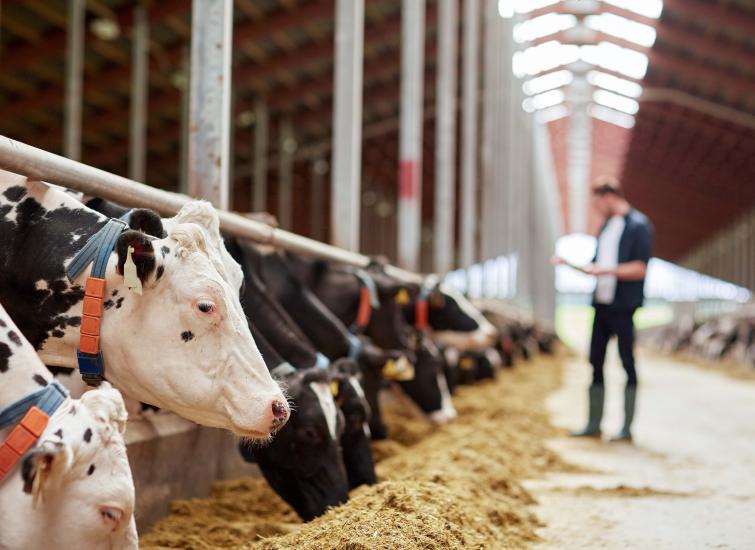After Advanced Nutrition's advice and using DC X-Zel for our transition cows we have found they are fitter and healthier. They don’t lose much condition after they calve, right through to lactation. They just calve down better.
Improving Feed Efficiency through Dietary Management
As margins have tightened through 2023 through falling milk prices the argument for improving feed efficiency has strengthened. Dairy Farmer reports.

While the direct link between feed efficiency and improved margin is compelling enough, there are also benefits to animal health and huge opportunities to improve the environmental sustainability of dairy production, says Will Tulley, veterinary nutritionist at Advanced Ruminant Nutrition.
He says: "Various measures of efficiency are in use, but the principle of improvement remains the same - increasing milk output per unit of input." Nutrition uses a system called Total Digestion Management (TDM) which is an holistic approach to feed efficiency, bespoke to each farm that they work with.
Mr Tulley says: 'We look at improving feed efficiency through a series of steps once we have thoroughly researched what is important to the farm in terms of achieving their own KPIs and what is economically viable.
"We then select an area that is going to give us the most gains and work on continual improvements from there." Mr Tulley says there are a number of points that are considered during this process, but it is important to decide what is economically viable for individual farms.
Rumen Function
Optimising rumen function is central when looking to enhance feed efficiency in dairy cows, says Mr Tulley. "Improvements in rumen health result in increased nutrient digestibility, meaning more nutrients available for milk production and a reduction in nutrient loss via faeces. "Ensuring a healthy rumen is not simply the formulation of the diet, though this has a big influence, but also means ensuring the diet is delivered and consumed as intended. "Environmental and management factors which influence eating and resting behaviour are pivotal to ensuring rumen stability. "The improvement in milk constituents seen with improved rumen health further increases feed efficiency."
Yield and Maintenance requirements
Mr Tulley says generally, increasing milk yield increases feed efficiency due to a 'dilution' effect of the cow's maintenance requirements. "For example, a cow yielding 45kg/day requires four times maintenance, whereas a cow giving 90kg/day requires seven times maintenance," he says.
"It stands to reason cows at peak lactation are more efficient than later lactation cows, which highlights the importance of herd fertility. "Understandably, heifers are less efficient than cows, partly due to reduced yields, but also because some nutrients are used for growth, showing the effect herd longevity has on feed efficiency."
Amino acid balancing and isoacids
The use of rumen-protected amino acids has a role to play when reducing dietary protein levels. Mr Tulley says, "Often methionine and lysine are the first amino acids to limit production in typical diets. "Research has also highlighted the health benefits of feeding rumen-protected methionine beyond fulfilling an amino acid requirement, including improved liver function and improved fertility through reduced uterine disease and better egg quality. "Recent work has also showed promise for the use of isoacids. "These are produced from the breakdown of proteins in the rumen and are required by rumen microbes.
"Supplementation of isoacids allows protein levels to be reduced without limiting rumen microbial activity and thus improves digestibility of fibre in particular. "The reduction of dietary protein cuts the need for expensive purchased protein sources and allows more home-grown feeds to replace them, such as forages or home-grown cereals."
Legumes
Mr Tulley says incorporating legumes into a farm's cropping programme can improve nitrogen efficiency at a farm level. He says: "The fixing of atmospheric nitrogen by legumes cuts the requirement for purchased fertiliser and the use of higher protein forages can further reduce the need for purchased protein feeds."
Dry matter intake
DM intake has a huge influence on feed efficiency and, if increased DM results in increased milk yield, then overall efficiency may improve. Alternatively, if DM intake is reduced with no change in milk yield, then efficiency improves.
"In both cases methane emissions per unit of milk are also reduced," says Mr Tulley. Although reducing feed refusals will improve feed efficiency, it is not recommended to have long periods of time where cows do not have access to feed, this is particularly true for transition cows. With consistent routine feeding management, including accurate forage, dry matter and cow numbers, refusals can be as low as 2-3% without hindering intakes."
Nitrogen efficiency
Nitrogen efficiency in dairy production is coming under increasing scrutiny due to environmental concerns around nitrogen excretion in slurry. Mr Tulley says: "This is one area of opportunity for many dairies, as both research and field work shows that lower protein diets can successfully support high yielding cows. "However, a more precise feeding approach is required for this; formulating diets to provide the cow with the amino acids she requires, rather than focusing on crude protein levels."
〈 BACK



